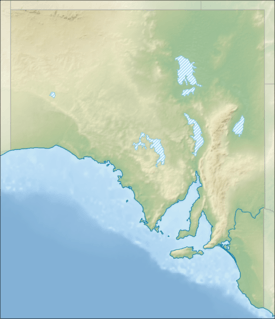Lake Hope (South Australia)
| Lake Hope | |
|---|---|
 Lake Hope Location in South Australia | |
| Location | Far North South Australia |
| Coordinates | 28°23′14″S 139°18′18″E / 28.38722°S 139.30500°ECoordinates: 28°23′14″S 139°18′18″E / 28.38722°S 139.30500°E |
| Type | Salt lake |
| Primary outflows | evaporation |
| Basin countries | Australia |
| Designation | Coongie Lakes Ramsar Site |
| Max. length | 12 km (7.5 mi) |
| Max. width | 2 km (1.2 mi) |
| Surface area | 36 km2 (14 sq mi) |
Lake Hope is an ephemeral salt lake in the far north of South Australia.
Description
It is situated approximately 160 kilometres (99 mi) south west of Innamincka and 180 kilometres (112 mi) north east of Marree. Both Lake Hope and nearby Red Lake are on the southern side of the Cooper Creek in the sand dune country. Both are also found within the boundaries of Mulka and Lake Hope Stations.[1]
The lakes are both within the Lake Eyre basin and a fishing licence has been issued for each of the lakes for an operation out of Mulka Station. The licence allows the removal of 350 tonnes (344 long tons; 386 short tons) of Lake Eyre Golden Perch, Welch's Grunter and the Barcoo Grunter but only once the lakes have disconnected from the Cooper Creek after a flood event.[2]
When full the lake occupies an area of approximately 3,600 hectares (8,896 acres) and is approximately 12 kilometres (7 mi) long.[3] The lake is filled periodically from the flooding of Cooper Creek. In 1990 waters from Cooper Creek reached Lake Hope but did not reach Lake Eyre.[4]
The traditional owners name for the lake is Pando penunie which means great lake. The first Europeans to discover the lake were S. J. and R. J. Stuckey in October 1859. The named the lake because they hoped for greater fortune in the future. Thomas Elder took up the first pastoral lease in the area in 1860.[5]
Lake Hope is located within the boundaries of the wetland system known as the Coongie Lakes which is both listed internationally under the Ramsar Convention and within Australia with an identical listing in "A Directory of Important Wetlands in Australia" (DIWA).[6][7][8]
See also
References
- ↑ "Lake Eyre Basin Fishery". Government of South Australia. 13 December 2013. Retrieved 22 August 2014.
- ↑ "Management Plan for the Lake Eyre Fishery" (PDF). Primary Industries and Regions South Australia. 1 March 2013. Retrieved 22 August 2014.
- ↑ "Map of Lake Hope (Pando), SA". Bonzle. 2014. Retrieved 22 August 2014.
- ↑ R. T. Kingsford, A. L. Curtin and J. Porter (11 May 1995). "Water flows on Cooper Creek in arid Australia determine `boom' and `bust' periods for waterbirds" (PDF). Biological Conservation. Elsevier Science. Retrieved 22 August 2014.
- ↑ "Lake Hope & Kopperamanna Police Stations". Flinders Range Research. 2013. Retrieved 22 August 2014.
- ↑ "Ramsar Sites Information Service: Coongie Lakes". Ramsar Secretariat. Retrieved 28 March 2015.
- ↑ Eyles, Kathy; Larmour, Geoff; Young, Sarah; Australia. Environment Australia; Natural Heritage Trust (Australia). National Wetlands Program (2001), A Directory of important wetlands in Australia (PDF) (3rd ed.), Environment Australia, pp. 1, 2 & 77, ISBN 978-0-642-54721-7
- ↑ Coongie Lakes Ramsar Wetlands: A Plan for Wise Use (Draft for public consultation) (PDF). Department for Environment, Heritage and Aboriginal Affairs (DEHAA). November 1999. pp. 19–20. ISBN 0 7308 5876 6. Retrieved 28 March 2015.